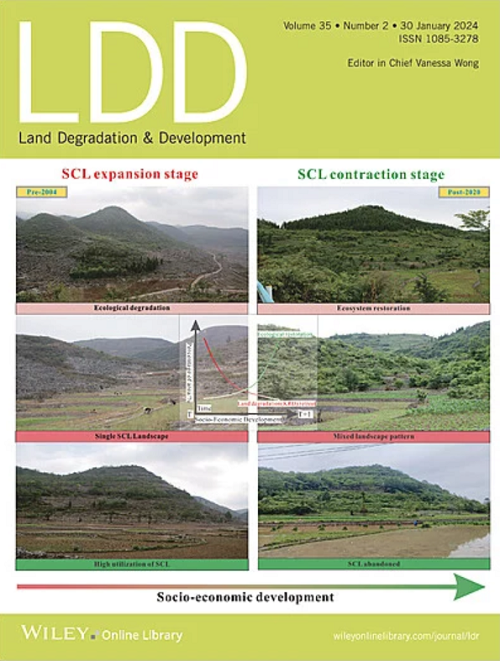Unraveling the Dual Impacts of Urbanization on Agricultural Habitats: A Telecoupling Perspective From Zhejiang Province, China
IF 3.7
2区 农林科学
Q2 ENVIRONMENTAL SCIENCES
引用次数: 0
Abstract
Urbanization exerts multifaceted pressures on agricultural systems by directly converting cropland into built‐up land and indirectly inducing cropland expansion elsewhere through displacement. However, most existing studies have narrowly focused on local land use/land cover changes, lacking an integrated understanding of how urbanization reshapes agricultural habitats through both direct and indirect pathways across regions. To address this gap, this study employs a telecoupling framework to assess the dual impacts of urbanization on agricultural habitats in Zhejiang Province, China. This study quantified cropland loss and cropland displacement driven by food production demand using land use/land cover conversion data, and applied a scenario‐based approach to distinguish the direct and indirect effects of urbanization on agricultural habitat quality. Between 2000 and 2020, built‐up land expanded by 158.09%, resulting in a 17.89% reduction in cropland. Urbanization directly caused a 15.44% loss in agricultural habitat and indirectly led to a 5.08% decline through the degradation of surrounding cropland. Although cropland displacement contributed to a 15.57% increase in agricultural habitat in other areas, these gains were achieved primarily at the expense of forested ecosystems and exhibited spatial mismatches with the original losses. These findings reveal that the indirect ecological responses to urbanization may partially counterbalance habitat losses locally, but also introduce potential trade‐offs and externalize ecological costs to distant landscapes. Our results highlight the importance of recognizing urban–rural teleconnections in land use planning and call for more integrative and spatially coordinated strategies to safeguard agricultural landscapes and biodiversity under ongoing urban expansion.城市化对农业生境的双重影响:来自浙江省的远耦合视角
城市化直接将耕地转化为建设用地,并通过流离失所间接导致其他地方的耕地扩张,从而给农业系统带来多方面的压力。然而,大多数现有研究只关注当地土地利用/土地覆盖的变化,缺乏对城市化如何通过区域间的直接和间接途径重塑农业栖息地的综合理解。为了解决这一差距,本研究采用了一个远耦合框架来评估城市化对中国浙江省农业栖息地的双重影响。本研究利用土地利用/土地覆盖转换数据量化粮食生产需求驱动的耕地损失和耕地迁移,并采用基于情景的方法区分城市化对农业栖息地质量的直接和间接影响。2000年至2020年,建设用地扩大了158.09%,耕地面积减少了17.89%。城市化直接导致农业生境损失15.44%,通过周边农田退化间接导致农业生境减少5.08%。虽然耕地迁移使其他地区的农业生境增加了15.57%,但这些增加主要是以牺牲森林生态系统为代价的,并且与原始损失在空间上不匹配。这些发现表明,城市化的间接生态响应可能会部分抵消当地的栖息地损失,但也会引入潜在的权衡,并将生态成本外部化到遥远的景观中。我们的研究结果强调了在土地利用规划中认识城乡远程联系的重要性,并呼吁在持续的城市扩张中采取更加综合和空间协调的战略来保护农业景观和生物多样性。
本文章由计算机程序翻译,如有差异,请以英文原文为准。
求助全文
约1分钟内获得全文
求助全文
来源期刊

Land Degradation & Development
农林科学-环境科学
CiteScore
7.70
自引率
8.50%
发文量
379
审稿时长
5.5 months
期刊介绍:
Land Degradation & Development is an international journal which seeks to promote rational study of the recognition, monitoring, control and rehabilitation of degradation in terrestrial environments. The journal focuses on:
- what land degradation is;
- what causes land degradation;
- the impacts of land degradation
- the scale of land degradation;
- the history, current status or future trends of land degradation;
- avoidance, mitigation and control of land degradation;
- remedial actions to rehabilitate or restore degraded land;
- sustainable land management.
 求助内容:
求助内容: 应助结果提醒方式:
应助结果提醒方式:


